A riot of colours interrupted my journey. The golden sunflowers nudged each other as they carelessly tossed their heads in the breeze. A montage of lush fields bordered by hills with rotating windmills on their summits rushed past . The simplicity lent a certain charm as I leaned against the trees and took in the silence. This was not a pleasure trip, but a journey that took me down eons of history . I was driving through Malenadu or the hilly regions of Karnataka, in search of a capital town that remained lost amidst the huddled hamlets.
More than 1000 years ago, sometime in the middle of 10th century, a dynasty was born in the Malenadu regions of modern day Karnataka. They were called the Hoysalas. They were not born kings, but were tribal chiefs who rebelled against the then rulers Chalukyas and went on to establish their own kingdom. There were 14 rulers who ruled for more than 300 years and their reign spread as far as Madurai in South to Lakkundi in the north . Their capital was initially Velapuri and then it moved on to Dwarasamudra . Today, we know the two towns as Belur and Halebeed. My destination however was the ancient town of Dwarasamudra, where I was looking for the remains of this dynasty .
My driver brought me to the 12th century Hoysaleshwar temple in modern day Halebeedu built by the aristocratic merchants, Ketamalla and Kesarasetti .The star shaped temple, a masterpiece of the Hoysala style of architecture was thronged by tourists who had probably just returned from the visit to the Chennakesava temple in Belur. Dedicated to Shiva and his pantheon of Gods and Goddesses, the main shrine here is named after the Hoysala king, Hoysaleshwara, who commissioned the temple.
A guide gathered his group of tourists and announced that there are more than 500 relief sculptures on the outer wall of the temple. I paused by to see the miniature friezes of elephants, horses and the mythical yalis .Stories from the Hindu epics and puranas were carved in stone here. As the tourists posed against the Nandi mantapas, I made my way inside into the temple, where another guide explained the importance of a Garuda pillar. There were carvings of soldiers with swords cutting their own heads.
“ These are not just dedicated to Garuda, the vehicle of Vishnu, but to loyal subordinates of kings who faithfully served them. The pillars are memorials to those who were like garudas to the kings.” Narrating a story from the pillar, he referred to the sacrifice of a devoted aide Kuvara Lakshma who along with his wife Suggala and thousand followers ended their lives after the death of the king, Veera Ballalla II.
The Hoysala kings are known for their style of temple architecture, but most of the temples today are either in ruins or in an obscure village waiting to be discovered .Historical records say 1521 temples were built while today 434 temples survive across 238 centres. My search for Dwarasamudra took me to some of them. There were ruins of old temples, Jain basadis and even the remnants of an old fort and a palace.
Halebeedu means ancient abode and I found myself in the old village which was once the mighty Dwarasamudra . The Benneguda hill is a witness to the once powerful empire which ruled from the 11th century capital. An ancient inscription in the village speaks of a battle fought here against the Kalachuriyas by Veera Ballalla II. A few tourists went boating on the lake. Interestingly that seemed to be the foundation of Dwarasamudra, which probably means Entry by Ocean.
The ancient Hoysala kings were ruling from Velapuri or Belur which was on the banks of the Yagachi river. When Vinayaditya decided to move to Dwarasamudra in the 11th century ,he decided to build a canal to channelize water from Yagachi to the new capital. A tank was built and the Hoysaleshwar temple was later constructed on the banks of the tank. An inscription on the tank gives away the name , Dwarasamudra which later became known as Halebeedu.” It means the old abode and we call it the old residence of Dwarasamudra, “ echoed the voice of the guide as I walked away from the throes of tourist into the bylanes of the ancient capital.
Hardly a stone’s throw away but cut off from the tourist circuit is a nonchalant hamlet Basadihalli with three Jinalayas . Dating to the period of king Vishnuvardhan, who was earlier a Jain called Bittideva , the basadis or Jinalayas are enclosed in the old Dwarsamudra town. A family enjoyed their picnic lunch as the watchman conversed with them .I walked inside amidst the rows of ornate pillars and realized the basadis have become the abode of bats.
The ASI board gave us some information. Dedicated to Parshwanatha, Shantinatha and Adinatha, these Jinalayas were built in memory of Ganga Raja, the army commander by his son, Boppadeva and to celebrate the victory of the king in the battle of Bankapura .The 16 feet tall sculpture of Parshwanatha with the four teerthankaras was a highlight of this basadi while the ornate pillars reminded you of the glory of the Hoysalas. Another tall pillar with a sculpture of Brahma stood outside one of them while the ancient well here was almost dry.
The afternoon breeze lifted my spirits as I followed the empty road in front of me . It ended in a much smaller temple called Kedareshwar constructed by Vira Ballalla II in the 13th century .Ironically, just a stone’s throw from the Hoysaleshwar temple, this shrine was devoid of tourists. An Indian grey hornbill perched on a branch overlooking a water body.
I took a detour and walked past a small hamlet. The Pushpagiri hill looked down upon me hidden by a cluster of small village homes. A gentle breeze led me down a small lane covered by a canopy of trees. As I strolled aimlessly, I stumbled upon an ancient kalyani, or pushkarni or a step well. A bunch of kids played on the steps and looked at me with a tinge of curiosity. The village was called Hulikere.
“ Huli means tiger and kere refers to a pond,” explained the watchman there.” This is Queen Shantala Devi ‘s private pond,” he added with a tinge of flourish. “You know, the security was so steep that even a tiger could not walk in to see her- that’s why its called Hulikere.” I took in the irony of security guards protecting the queen and her maids from tigers while bathing and pottered around. Small shrines adorned the steps of the well, while the fluffy clouds reflected in the waters . Frogs hopped around with the fish swimming blissfully in this heritage pond. Historians feel the shrines probably represent the cosmos with the zodiac signs and constellations.
An ASI guide book referred to a Bhuvanabhurana Catteshwara temple built at Hulikere by Cattaya, a subordinate of King Narasimha , one of the Hoysala rulers. When the king was going to Belur from Dwarasamudra , his carriage driver , Bittideva noticed a desolate temple and asked the ruler to give grants and renovate it. The king gave away dry and wet lands, a tank, oil mills for supply of oil to burn lamps and established a Saivite settlement with two rows of houses . Bittideva also received grants and built the Maideshwara temple and Bittideshwara temple in the vicinity. The area is today identified around Hulikere and Pushpagiri at the periphery of the Dwarasamudra.
A shrill cry of parakeets interrupted my reverie. The children got over their shyness and were all willing to pose for pictures in return for chocolates .I continued my quest until I see the ruins . With the Bennegudda hill looking down on them, the remnants of the old city stood silently. Around it a strong fort was probably built. The fragments indicated that there seemed to have been a palace here as well, The Archaeology Survey Site also mentioned there were three temples in this complex, of which some friezes still remained.
A few pedestals, including one with a Linga is in the centre surrounded by carved stones, while a few headless sculptures lay strewn around. This was the capital of a dynasty that once defeated the Chola, subdued the Chalukyas , overthrew the Kadambas and Pandyas and controlled the Kalachuryas before being destroyed by internal strile and finally ravaged by the Muslim invaders in the 14th century.
The sky changed colours as dusk set in lending a purple glow. I sat on the steps of the ruined temple and ruminated over the dynasty’s end. Somewhere in the middle of the 13th century, the Hoysala kingdom was divided between two brothers, Narasimha III who ruled from Dwarasamudra ,and Ramanatha from Kannanur. The brothers fought over Dwarasamudra even as Narasimha III’s son Veera Ballalla III came to the throne. He eventually became the last king of the dynasty. Although he defended his capital , fought his uncle and kept the neighbouring rulers at bay, the final blow came in the form of Malik kafur, a general of Alauddin Khilji who invaded south in the 14th century.
The invaders forced Ballalla III to submit and looted him of 312 elephants, 20,000 horses besides jewellery of gold and pearls. Dwarasamudra was plundered and the temples destroyed as Ballalla fled to Belur and further south. A few years later, the king returned and attempted to rebuild Dwarsamudra , but the Muslim onslaught continued. As Dwarasamudra was further destroyed, the king fled to Tiruvannamalai , but died in Madurai while fighting the invaders. It is said the cruel blow came when “ the captured king was slain and skinned , his skin was stuffed with straw and hung from the top of the walls from Madurai. “ Ibn Battuta, the Morroccon traveler who was in the court of Muhammad bin Tughluq, the reigning Sultan at the time records this as I put the history book down with a heavy heart.
Outside the air became solemn as twilight set in. As the dynasty ended , Dwarasamudra disappeared into the dusty annals of history . Halebeedu took over from Dwarasamudra and found its place in another map – the tourist’s agenda. The lights came up at the Hoysaleswara temple as the last set of tourists posed for a picture against the monument and grabbed a piece of history unknowingly with them. The sun may have set on the dynasty a 1000 years ago, but they made sure they left their glory behind in the temples they have built.
This story was published in Windows and Aisles, the inflight magazine of Paramount Airlines. If you would like to be a part of the Hoysala trail, leave a comment here , with your email ID and we will let you know when we plan the trail. If you would like to go on your own and need a help in planning an itinerary, do let me know as well.

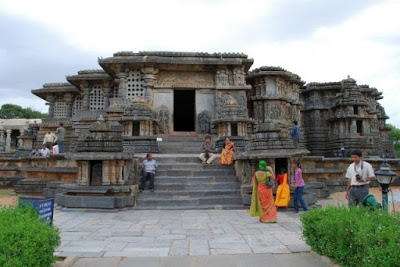
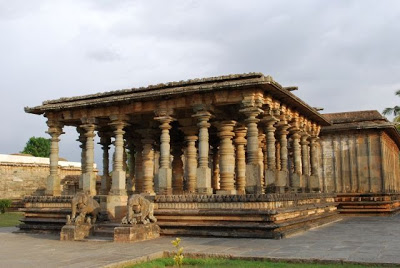

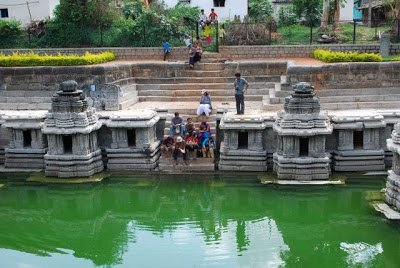
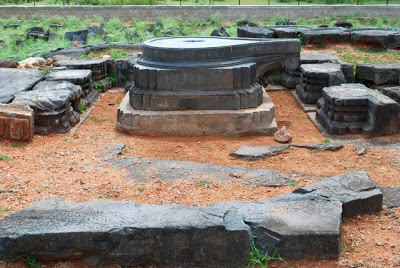
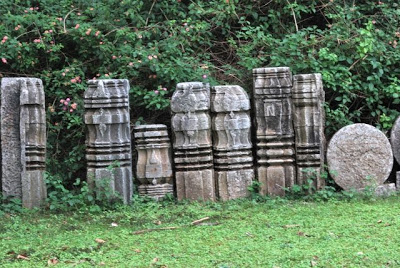
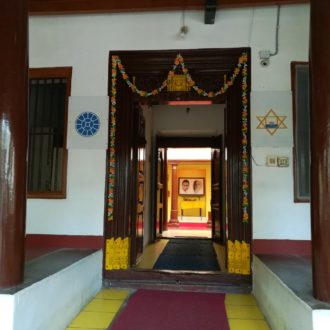
What a lovely account of a beautiful discovery filled trip.
Wonderful trip of the place with lot to discover. In my next trip to this place, I shall surely explore this trail.
Beautiful! <3
http://www.missemy07.blogspot.com
What an awesome, informative write up! When I do visit this place, I will take a printout of this post as reference material coz it is so detailed and interesting. Thanks for sharing.
I have been following your Hoysala trail in the Hindu and ofcourse at Arun’s Blog. This will serve as a guide for my visit, Congragulations for this enchanting research
That was a wonderful write up. I was searching for details about Hulikere and landed up here. We are actually trying to visit all the hoysala ruins by this october. A short three day trip which we like to rush a bit to cover places. If you know any places other than Somnathapura, Halebidu and Belur please let me know. My E-mail is [email protected]
Thanks for the beautiful write ups. I have already visited Halebeedu, Belur and Somnathpura and Talakadu. It will be my pleasure, if you can supply any information about Hoysala temple around Mysore. Another thing – will you please check the year of invasion by Malik Kafur (Hazardinari), the eunuch general of Ala ud din Khilji as well as by Muhammad bin Tughlak
A very informative write up. Though I visited Halebeedu twice, once in 1971 and again in 2016, both visits were hurried. I am keen to make another visit. This time I want to make it a complete visit. Please let me know the next time you plan a trail. Alternately, please give me a brief toplan my itinerary. Thanks.